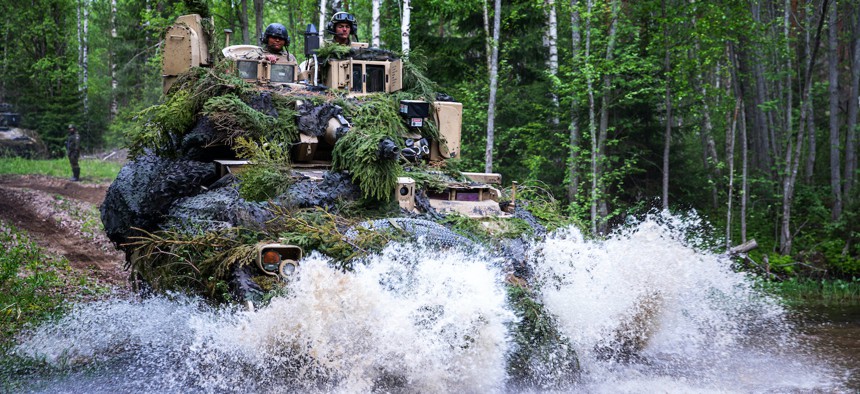
Soldiers navigate a Bradley fighting vehicle through the battlefield during Karelian Lock 23 in Pahkajarvi Training Area, Finland, May 31, 2023. U.S. Army / Sgt. Brayton Daniel
Army Picks Two Finalists to Replace Bradley
The two competitors will now turn their digital designs into prototypes.
The Army chose General Dynamics Land Systems and American Rheinmetall Vehicles to compete in the final round to replace the Bradley Infantry Fighting Vehicle—an 80s-era design that the Army says has reached its limits.
The contracts will be worth around $1.6 billion, according to an Army press release. The program’s total value has been previously valued at $45 billion.
The Army also will rename the Bradley’s replacement as the XM30 Mechanized Infantry Combat Vehicle, said Doug Bush, assistant Army secretary for acquisition, logistics, and technology. It was formerly known as the Optionally Manned Fighting Vehicle.
The two competitors, who already presented digital designs, will now build as many as 11 prototypes for testing. The XM30 is the first Army vehicle to be first designed digitally before the creation of a real-world prototype, Bush said.
The two companies will further develop their designs, and begin building prototypes in the first quarter of 2025 with the first prototypes delivered 18 to 24 months later, according to Maj. Gen. Glenn Dean, the program executive officer for ground combat systems. The Army will choose a winner toward the end of fiscal year 2027, with plans to equip the first unit by 2029.
Choosing two finalists rather than one winner is unusual, Bush said, and the move is intended to get the most competitive final product.
The XM30 will be armed with a 50mm cannon, machine guns, and anti-tank missiles, and will be protected by “integrated active protection systems and signature management capabilities.” Integrated active protection systems use sensors and projectiles to intercept incoming anti-tank missiles, while signature management capabilities seek to reduce an enemy’s ability to see a vehicle through the use of infrared, thermal, or other sensors.
A crew of two will man the vehicle, taking on the duties of commander, gunner, and driver. Infantry vehicles typically have three crew members.
Bush said the reduction in crew size is due to the use of automation to take over tasks. While past officials have noted that current crews might feel uncomfortable with a two-man crew, Bush doesn’t anticipate that problem.
“Eighteen-year-olds operating this vehicle will probably be pretty comfortable with a lot of technology enabling what they’re using the vehicle for,” he said.
The vehicle will be able to carry six soldiers—the same number as the Bradley. The crew and passenger number was selected after 11 studies that sought to achieve the optimal vehicle weight and armor, said Brig. Gen. Geoff Norman, director of the Army’s Next-Generation Combat Vehicles Cross Functional Team.
The inside of the vehicle interior is designed to be accessible to 95 percent of Army service members, including both men and women, he added.
The vehicle will also be designed so one C-17 can carry two of the vehicles. The aircraft can carry three Bradleys.
While billed as an “optionally manned fighting vehicle,” current plans stop short of a killer robot. At present, automation is reserved to navigating from point to point, although more autonomous functionality may come as designers develop the vehicle. “This is not something in 2029 that we anticipate fighting completely without personnel,” Dean said.
The vehicle’s design is intended to be modular to allow future technologies to be included later, Bush added.
The XM30 will be the first Army armored combat vehicle to feature a hybrid electric engine, which will allow the vehicle to idle silently, Bush said. Idling silently preserves fuel and reduces the heat and noise signatures that could give a vehicle’s position away to an enemy.
Amid intense demand abroad for American military goods in part due to Russia's invasion of Ukraine, Dean said the vehicle would be designed for exportability.
Barriers to export include sensitive technologies that either must be removed or replaced before export, as with the M1 Abrams tank.
After several false starts to pick a successor to the Bradley, a vehicle that itself had a famously tortured design process, Bush was upbeat about the prospects for the XM30. “I think we’re on much firmer ground,” he said. “This is going to succeed.”




